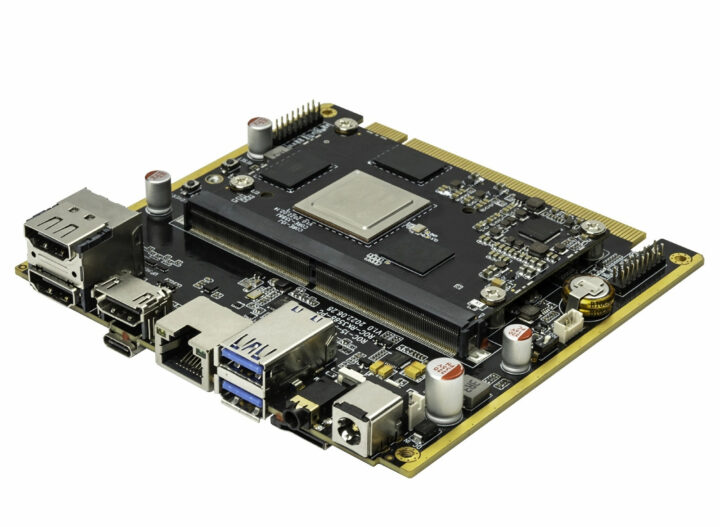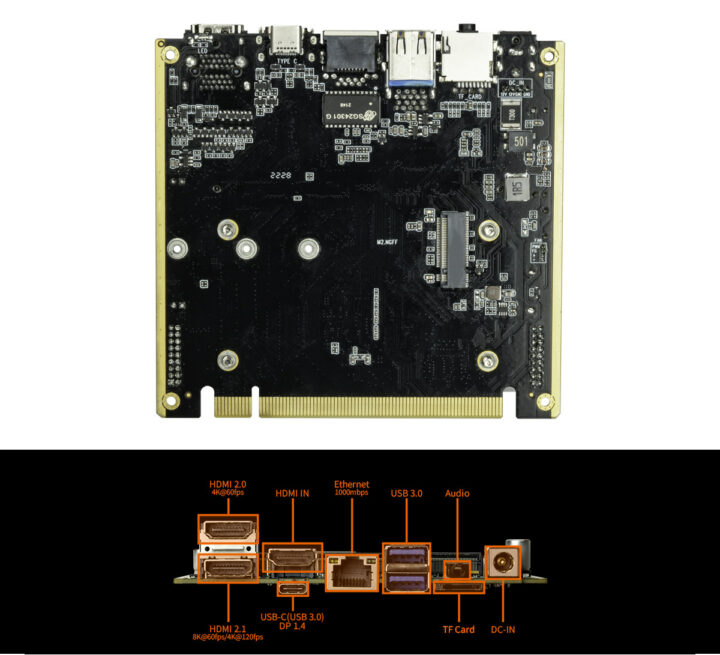The Rockchip RK3588 datasheet clearly states the processor supports up to 32 GB RAM, and many vendors claimed their board supports up to 32GB RAM at launch, but none were to be found once you accessed a shop, and the maximum was 16GB RAM so far, likely due to availability and the high price of of the two 16GB RAM chips needed to get 32GB of RAM.
But Firefly has now discreetly started to sell boards with 32GB RAM including the ROC-RK3588-PC, ROC-RK3588S-PC, and ITX-3358J mini-ITX motherboard. I’ve just noticed I never covered the former, so I’ll have a closer look at it today.
Firefly ROC-RK3588S-PC specifications:
- SoM – Core-3588J system-on-module
- SoC – Rockchip RK3588 octa-core processor with 4x Cortex-A76 cores @ up to 2.4 GHz, four Cortex-A55 cores, Arm Mali-G610 MP4 quad-core GPU with OpenGL ES3.2 / OpenCL 2.2 / Vulkan 1.1 support, 6 TOPS NPU, and an 8Kp60 H.265/VP9/AVS2 video decoder, 4Kp60 decoder, 8Kp30 H.265/H.264 video encoder
- System Memory – 4GB, 8GB, 16GB, or 32GB LPDDR4/LPDDR4x/LPDDR5
- Storage – 16GB, 32GB, 64GB, 128GB, or 256GB eMMC flash
- PMIC – Rockchip RK806-1
- Carrier board interface – 314-pin MXM 3.0 edge connector
- Dimensions – 82 mm × 53 mm
- Carrier board
- Storage
- M.2 (PCIe 3.0) socket for M.2 2242/2260/2280 NVMe SSD
- MicroSD card slot
- Video Output
- HDMI 2.1 port up to 8Kp60
- HDMI 2.0 port up to 4Kp60
- DisplayPort 1.4 up to 8Kp30 via USB-C port
- Up to two independent video outputs
- Video Input – HDMI input
- Audio
- 3.5mm audio (headphone+mic) jack
- Digital audio output via HDMI and DP ports
- Line OUT on header
- Networking
- Low-profile Gigabit Ethernet RJ45 port
- Dual-band WiFi 6 (802.11ax) and Bluetooth 5.0
- USB – 2x USB 3.0 Type-A ports, 1x USB Type-C port with DP Alt mode
- Expansion
- M.2 (PCIe 3.0) socket for NVMe SSD
- 164-pin “PCIe 16x” edge connector with
- Display – MIPI DSI, VGA, DP 1.4
- Camera – MIPI CSI
- Audio – S/PDIF
- Networking – Gigabit Ethernet, 5G/4G LTE interface
- USB – USB 3.0
- Serial – CAN Bus
- PCIe – PCIe 2.0
- Low-speed I/Os – I2C, UART, PWM
- Headers with UART, ADC, CAN Bus, Debug, SPI, I2C, and Line Out
- Power Supply – 12V DC input via 5.5×2.1mm DC jack
- Dimensions – 118 x 111.6 mm
- Storage
- Power Consumption
- Idle: 1.2W (12V/100mA)
- Typical: 8.04W (12V/670mA)
- Max: 14.4W (12V/1,200mA)
- Weight – Around 150 grams
- Temperature Range – Operating: -20°C to 60°C; storage: -20°C to 70°C
- Humidity – 10% to 80% (storage)
The company provides Android 12, Debian, and Ubuntu images, Android and Linux SDKs, an HDMI input demo, tools, and some documentation on the download page. But you’ll find more resources to get started and instructions to use the various interfaces in the Wiki.
So how much does a Rockchip RK3588 SBC with 32GB RAM (and 256GB eMMC flash) cost exactly? At the time of writing…
- The ROC-RK3588S-PC can be purchased for $469 on the Firefly store.
- The ROC-RK3588-PC is available for $549 on Aliexpress or $615 on the Firefly store.
- The full-featured ITX-3388J mini-ITX goes for $829 on the company’s store.
I’m assuming other companies will follow suit soon, and offer some of their boards with 32GB RAM as well.
Thanks to Calvin for the tip.

Jean-Luc started CNX Software in 2010 as a part-time endeavor, before quitting his job as a software engineering manager, and starting to write daily news, and reviews full time later in 2011.
Support CNX Software! Donate via cryptocurrencies, become a Patron on Patreon, or purchase goods on Amazon or Aliexpress






